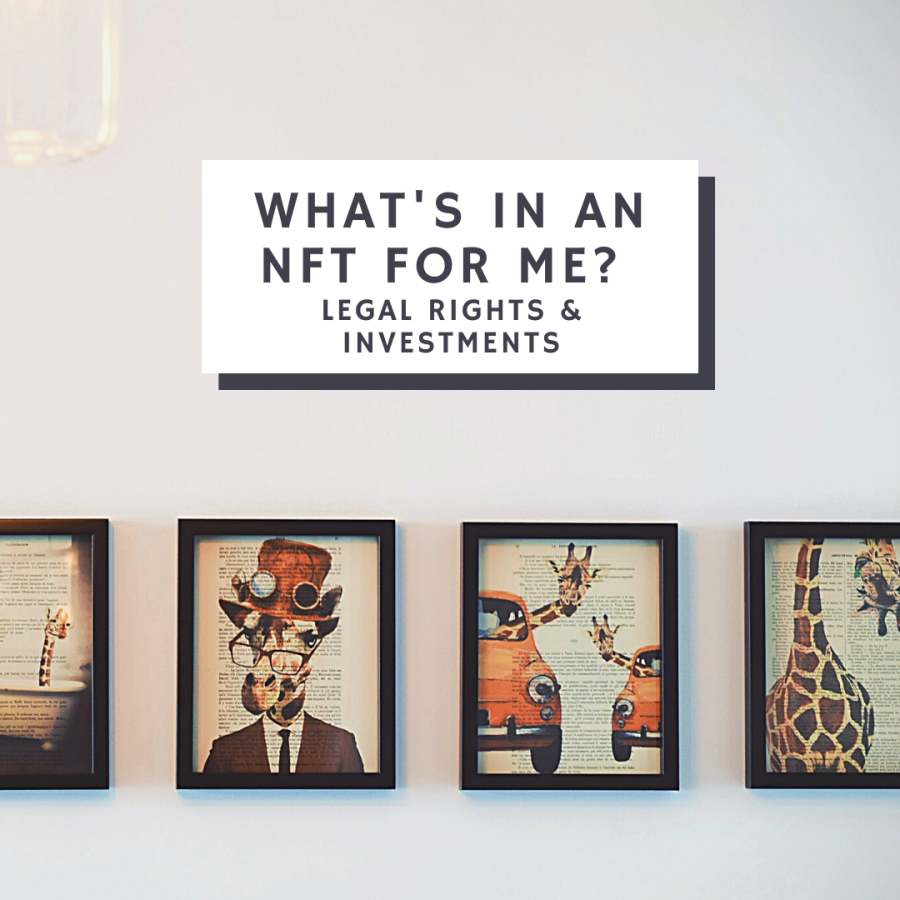For anyone who has been paying attention, NFTs are not a new concept. But, they have been receiving more and more media attention lately. Just this week, the popular “Disaster Girl” meme, picturing a smirking girl in the fore of a burning building, sold for $500,000.
So, what are NFTs, what are the copyright issues surrounding them, and are they a good investment? I’m joined for this blog by Longmont’s only fee-only Certified Financial Planner, Daniel Yerger of MY Wealth Planners, who will touch on the investment aspects of this commodity.
What is an NFT?
NFT is short for non-fungible token. In the simplest of layman’s terms (and mostly because I hold no sophisticated understanding of the technology or blockchain), NFTs are essentially a digital validation of ownership that are stored in a blockchain. NFTs can refer to ownership of any type of nonfungible asset, which means that the asset cannot be traded one for one for another asset of the same description. For example, while one ten dollar bill can be traded for other dollar bills, a painting by a particular artist is not readily tradeable for another random painting. NFTs have largely been used to register ownership of digital assets such as digital art or files.
Some recent examples
Some recent examples of the content that is being represented by NFTs (more on that distinction below) are below. As represented by these examples, NFTs can cover original art, and videos of real life experiences:
https://maintenance.nbatopshot.com/
NFTs are selling for massive amounts. In March, 2021, Christie’s auctioned off an NFT for the staggering price of $69M dollar, (see more on that, below). Purchasers, excited by the buzz around NFTs are rushing to the marketplace, hoping to score big. And, for some artists the payoff has been immense. Good for them–NFTs were initially developed to help protect artists and allow them to make money. Anil Dash, one of the artists credited with creating NFTS, has stated:
“Technology should be enabling artists to exercise control over their work, to more easily sell it, to more strongly protect against others appropriating it without permission. By devising the technology specifically for artistic use, (Kevin) McCoy and I hoped we might prevent it from becoming yet another method of exploiting creative professionals.”
Sounds a lot like what copyright was originally intended to do, right?
What rights are obtained if I purchase an NFT?
In the world of artistic expression, there is a distinction between owning a physical piece of art and the underlying copyright, which allows the copyright holder to control how others make copies, distribute, edit, perform and display the work. In a traditional scenario, if you buy a painting from a gallery, you own the physical copy of the art, but usually not the copyright. Unless it has been transferred to you, the artist will retain the copyright and can, for example, authorize advertisers to use copies in their ads, allow publishers to use photos of the work in their coffee table books, and even rework the art into new creations.
When an NFT is purchased, the scenario changes. The purchaser owns the token of authentication, that contains a link to the work. Not only does the NFT owner not own the copyright tor any control over the way copies are distributed, as in a traditional purchase of art, but an NFT owner does not even own the actual piece of art. They have essentially purchased a special print of the art, that can be authenticated as belonging to them.
And, what that also means is that the author of the underlying creative work still owns the copyright to the work represented in the NFT, along with all the rights that entails. Creators of NFTs must obtain permission from the copyright owner of the original content to even create the NFT to start. And, some copyright owners may not be willing to grant that permission. Famously, Stevie Nicks recently denied Nathan Apodaca, the juice drinking, skateboard riding, Fleetwood Mac-grooving social media sensation, permission to create and sell an NFT of his famous TikTok post.
All this is to say that if you want to dip your toes in the growing world of NFT ownership, make sure that you understand what you are purchasing. And, check the contracts and licenses that apply to your purchase to more fully understand if there is any copyright being transferred to you.
What if someone creates NFTs of your works?
If you have created a work and a third party attempts to monetize a copy of your work by creating an NFT without permission, copyright law will still help you find relief.
File Digital Millennium Copyright Act takedown notices for any sites that are advertising the sale. Many sites are instituting specific DMCA policies geared toward NFTs. Consider early registration of your work with the copyright office. Timely registration allows you to obtain benefits if an infringement case becomes necessary, and registration is required before you can gain access to the courts.
Other intellectual property rights such as trademark, patents, privacy and publicity rights may also be implicated, depending on the content of the NFT. Permission from these rights holders may also be necessary, dependent on the specifics of the NFT.
Given the thin ownership rights with NFTs, are they a good investment?
I’ll let Daniel Yerger explain this part:
Investing in an NFT is similar to investing in most other forms of collectibles: the potential return on the investment is simply based on the demand for the asset. However, NFTs have two unique risks that aren’t shared by other assets.
First, that the NFT is only non-fungible in its tokenization, but that does not prevent digital copies of the art itself from being distributed (much as a photograph of art is difficult to prevent from being distributed). Common examples have been clips of sports events or samples of music, which while the token is owned by the NFT owner, does not mean that the owner has control over the film or clips themselves.
Second, that the NFT has no intrinsic value. Unlike a tangible asset like a gold coin, which has some intrinsic value from the materials it’s composed of (i.e., the ounces of gold in the coin could be melted down and used for electronics components), an NFT is an intangible digital asset that simply represents ownership of itself. Buying an NFT does not create ownership of the physical or digital art itself unless the creator of the art and NFT decides to combine the two; but even then, aside from the potential to charge admission to view the digital art, there’s not much to be said for the NFT itself.
Ultimately, the potential return on an NFT is highly speculative, and like other forms of collectible investment relies on the belief that in the future, the demand for the asset will be greater than it is currently, thus driving up the value. For example, the most expensive NFT to date was listed at a price of $69,346,251; to make a return on an investment in this NFT would require that in future, there would be enough demand for it that someone would be willing to pay more than $69,346,251 for the NFT.
So should you invest in an NFT? Well, here’s the advice I give all investors about all speculative assets: Would you be willing to put the same amount of money from the investment through a paper shredder? If you’re willing to accept the risk that a speculative investment could lose all of its value, then it could be worth the potential risk. If you can’t afford to lose the money, or you don’t see the return as being greater than the potential loss, then you should probably consider other options.
Practical Applications & Real-World Impacts of Non-Fungible Tokens
Despite the significant investment risk posed by speculating in NFTs, there is still a real-world application and there are real world impacts to NFTs. It is likely that in future we will see digital assets such as digital theater tickets being secured by an NFT protocol, thus reducing the risk of counterfeit or forged digital tickets.
Like the blockchain underlying speculative cryptocurrency assets, while the investment quality of the current applications of NFTs is questionable, the underlying technology is valuable as a form of security. However, the production of NFTs and other assets on blockchain authenticated systems does have a serious negative impact on the non-digital world.
The protocols required by blockchain to produce new cryptocurrencies and digital investment assets currently run on a validation system called “proof of work”, which essentially requires computer processing systems to run on a “virtual treadmill” of mathematics calculations. When the calculations are completed, then the tokenization of a digital asset is completed, and the digital asset becomes real, or as real as a digital asset can be.
However, this proof of work process requires enormous computing power in some cases, and computing power requires computer hardware, which runs on electricity. At the present time, it’s estimated that the cumulative proof of work being done for assets stored on blockchain protocols is equivalent to the energy usage of the country of Argentina, which is the 26th largest economy in the world. As a result, NFTs and other blockchain assets are enormous consumers of energy, which have very real environmental impacts, and for those with environmentally conscious viewpoints, may pose a significant concern.
Daniel M. Yerger, MBA, CFP®, ChFC®, AIF®, CDFA® is the President of MY Wealth Planners®, a fee-only financial planning firm in Longmont, CO, and a Ph.D. in Personal Financial Planning student with Kansas State University.
Caroline Kert is a business attorney and litigator and the founder of Creative Legal, where she focuses on entity formations, contracts, intellectual property, arts & entertainment, employment, and business litigation.

